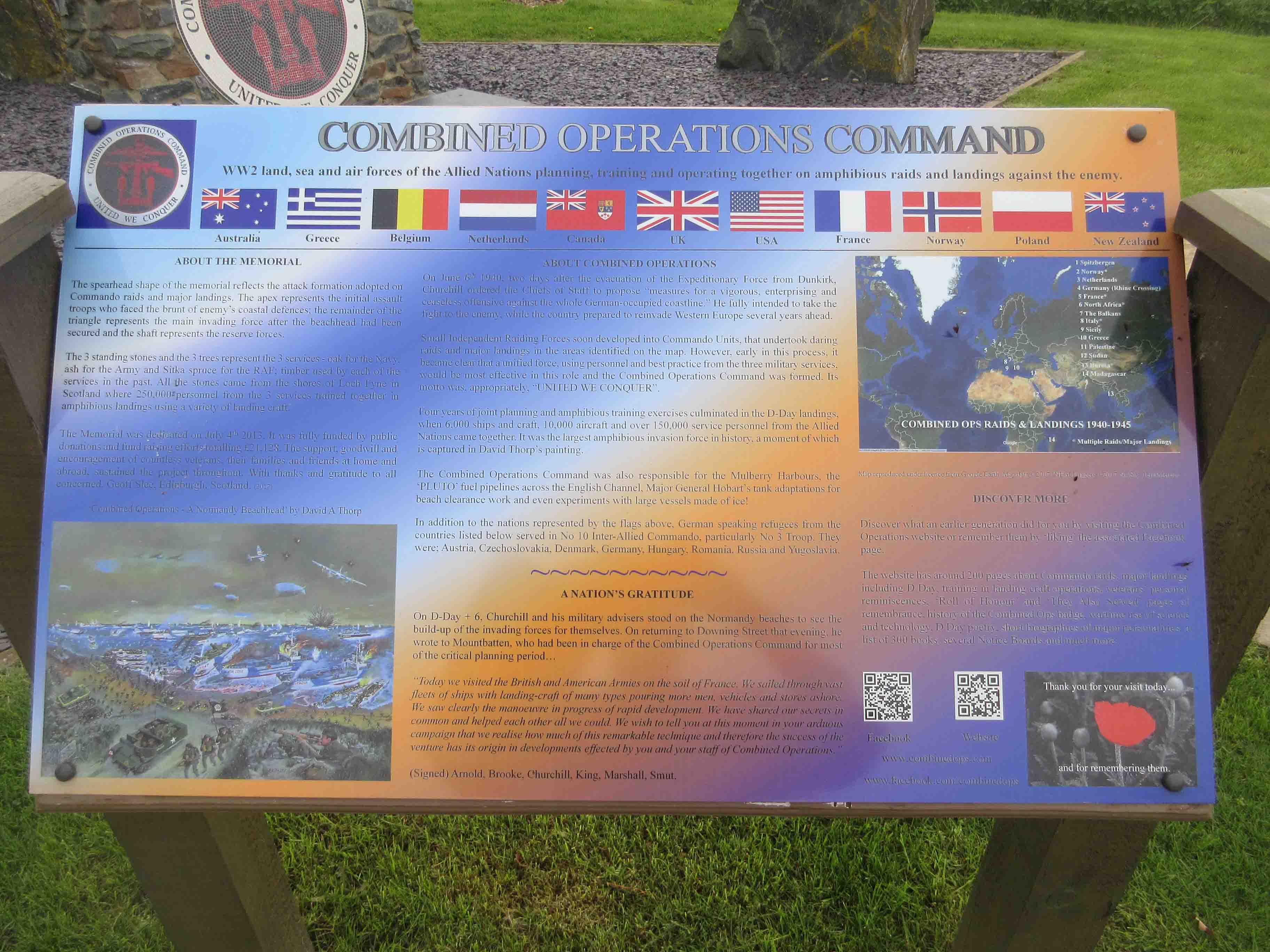Combined Operations Memorial - Information Board
Details:
On the left hand side in front of the monument.
A rectangular board with gradient background, inscribed in English text which explains about the memorial and the combined operations. It is also printed with various images as well as the flags of different countries. The current board is the replacement of the original, which was damaged in 2016.
Source of images: https://combinedops.com, https://www.warmemorialsonline.org.uk
Monument Text:
COMBINED OPERATIONS COMMAND
WW2 land, sea and air forces of the Allied Nations planning, training and operating together for amphibious raids and landing against the enemy.
(-Flags of the Australia, Greece, Belgium, Netherlands, Canada, UK, USA, France, Norway, Poland, New Zealand-)
First Column:
ABOUT THE MEMORIAL
The spearhead shape of the memorial reflects the attack formation adopted on Commando raids and major landings. The apex represents the initial assault troops who faced the brunt of enemy's coastal defences; the remainder of the triangle represents the main invading force after the beachhead had been secured and the shaft represents the reserve forces.
The 3 standing stones and the 3 trees represent the 3 services, - oak for the Navy, ash for the Army and Sitka spruce for the RAF; timber used by each of the services in the past. All the stones came from the shores of Loch Fyne in Scotland where 250,000 personnel from the 3 services trained together in amphibious landings using a variety of landing craft.
The Memorial was dedicated on July V' 2013. It was fully funded by public donations and fund raising efforts totalling £21,128. The support, goodwill and encouragement of countless veterans, their families and friends at home and abroad, sustained the project throughout. With thanks and gratitude to all concerned. Geoff Slee, Edinburgh, Scotland. (2017).
-Combined Operations - A Normandy Beachhead' by David A Thorp
(-image here-)
Second Column:
ABOUT COMBINED OPERATION
On June 6th 1940, two days after the evacuation of the Expeditionary Force from Dunkirk, Churchill ordered the Chiefs of Staff to propose "measures for a vigorous, enterprising and ceaseless offensive against the whole German-occupied coastline." He fully intended to take the fight to the enemy, while the country prepared to reinvade Western Europe several years ahead.
Small Independent Raiding Forces soon developed into Commando Units, that undertook daring raids and major landings in the areas identified on the map. However, early in this process, it became clear that a unified force, using personnel and best practice from the three military services, would be most effective in this role and the Combined Operations Command was formed. Its motto was, appropriately, "UNITED WE CONQUER".
Four years of joint planning and amphibious training exercises culminated in the D-Day landings, when 6,000 ships and craft, 10,000 aircraft and over 150,000 service personnel from the Allied Nations came together. It was the largest amphibious invasion force in history, a moment of which is captured in David Thorp's painting.
The Combined Operations Command was also responsible for the Mulberry Harbours, the `PLUTO' fuel pipelines across the English Channel, Major General Hobart's tank adaptations for beach clearance work and even experiments with large vessels made of ice!
In addition to the nations represented by the flags above, German speaking refugees from the countries listed below served in No 10 Inter-Allied Commando, particularly No 3 Troop. They were; Austria, Czechoslovakia, Denmark, Germany, Hungary, Romania, Russia and Yugoslavia.
~~~~~~~~~~~~~~~~~~~~~~
A NATION'S GRATITUDE
On D-Day + 6, Churchill and his military advisers stood on the Normandy beaches to see the build-up of the invading forces for themselves. On returning to Downing Street that evening, he wrote to Mountbatten, who had been in charge of the Combined Operations Command for most of the critical planning period...
"Today we visited the British and American Armies on the soil of France. We sailed through vast fleets of ships with landing-craft of many types pouring more men, vehicles and stores ashore. We saw clearly the manoeuvre in progress of rapid development. We have shared our secrets in common and helped each other all we could We wish to tell you at this moment in your arduous campaign that we realise how much of this remarkable technique and therefore the success of the venture has its origin in developments effected by you and your staff of Combined Operations."
(Signed) Arnold, Brooke, Churchill, King, Marshall, Smut.
Third Column:
(-map here)
Map reproduced under licence from Google Earth. Map data 02017 INEGI Imagery 02017 NASA, TerraMetrics
DISCOVER MORE
Discover what an earlier generation did for you by visiting the Combined Operations website or remember them by 'liking' the associated Facebook page.
The website has around 200 pages about Commando raids, major landings including D Day, training in landing craft operations, veterans' personal reminiscences, 'Roll of Honour' and 'They Also Served' pages of remembrance, history of the Combined Ops badge, wartime use of science and technology, D Day poetry, short biographies of major personalities, a list of 300 books, several Notice Boards and much more.



